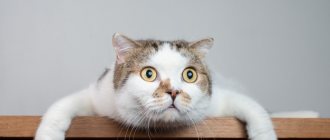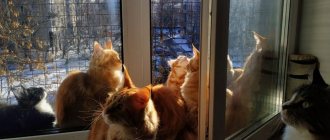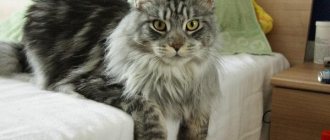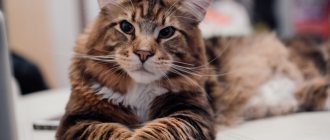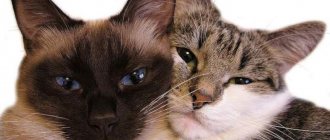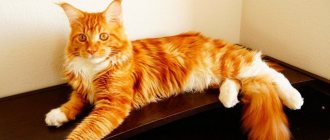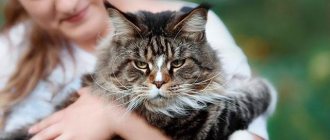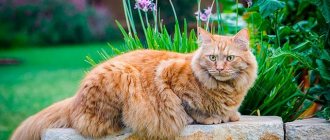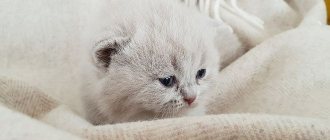There are many international felinological associations, but they have different standards for conducting shows and even criteria for evaluating cats. The same Maine Coon is capable of leaving the ring with the rank of champion or not even receiving a diploma - it all depends on the prevailing competitive circumstances and the conditions of the competition. Not all pet lovers are familiar with the rules of exhibitions.
Let's find out how authoritative felinological organizations determine the breed standard.
WCF system (Europe)
At open exhibitions, judges describe the animal, evaluate its character and appearance in accordance with internal rules also adopted among other European organizations. Owners of all breeds will be present during the inspection of the exhibitor. An exhibitor can receive a maximum of 1 rating per day.
Standard according to WCF:
- Body. Rectangular in format, large or very large, well-developed muscles, wide chest.
- Limbs. Medium length, strong and muscular. There are tufts of fur on the paw pads, between the toes.
- Tail. Long, reaches to the shoulder. Wide at the base, tapering towards the end. Covered with long hair.
- Scull. Square, large, with a clearly defined transition from the muzzle to the forehead. The chin, nose and upper jaw are level.
- Eyes. Large, oval, set wide and slightly oblique. The color matches the coat color.
- Ears. Large, wide at the base and tapering towards the tip. The distance between them is no more than the width of the ear at the base. The posture is high and almost vertical. The presence of tassels at the tips is a desirable, but not mandatory, component of the exterior.
- Coat. Waterproof, fits tightly to the body, covers half the tail, back of the body and limbs. The undercoat, unlike the topcoat, is soft and dense. There is only undercoat on the belly and “pants”. A lush mane is a desirable, but optional criterion.
- Color. Any options are allowed, except for chocolate, lilac, caramel and cinnamon color in any combination.
The disadvantage that does not allow one to qualify for the CAC title is the coat of the same length throughout the body.
Photos from the exhibition
Maine health
Maine Health
Genetically, kittens have an increased risk of polydactyly. This manifests itself in the presence of extra toes on the paws. The defect does not affect the health and activity of the animal.
But such cats cannot be bred as breeding animals. Coons often suffer from heart disease. They have hypertrophic cardiomyopathy. It can cause sudden death and is diagnosed by ultrasound.
Among hereditary diseases, polycystic kidney disease often manifests itself - the presence of small formations with fluid in these organs. The size of these cysts increases as the animal grows and can cause death. This breed is also genetically predisposed to urolithiasis and joint diseases, especially hip dysplasia. To prevent the cat from encountering these troubles, it must be taken to the veterinarian for examination in a timely manner.
Disease Prevention
To keep your pet healthy, you need to follow several rules. The best prevention is a proper and balanced diet, the basis of which is lean meat. Be sure to regularly vaccinate your pet. The first vaccine is given at 2.5 months, and then once a year.
TICA (America)
The second largest felinological organization in the world, founded in 1079, its main office is in the USA. Exhibition activities comply with American rules and require open judging and the judge not having any information about the animal and its titles.
TICA unites not clubs, but Maine Coon breeders and owners, and the judges of this organization must regularly confirm their qualifications.
TICA standard:
- Head. Wide, in the shape of a modified wedge, the forehead is rounded, the cheekbones are prominent.
- Ears. Large, with a wide base, medium pointed, set high relative to the head, the auricle is slightly inclined outward.
- Eyes . Large, set wide. Their color has nothing to do with the color of their coat.
- Color. Any color is acceptable, as well as a white outline around the chin, eyes and lips.
- Coat. Serves as protection from weather conditions; there is a small undercoat, the quality of which should be different from the outer coat.
A Maine Coon can be fined for:
- Eyes wide open.
- Small size.
- Rounded head shape.
- Short tail.
- Long limbs.
- The coat is the same length.
- Specks, spots.
- Sparse undercoat.
- Almond-shaped eyes.
- Ears located close to each other.
- Short tail.
Reasons for disqualification:
- Aggressive behavior, attempts to bite or scratch the judge.
- Cryptorchidism.
- Lack of tail, its creases.
- Strabismus, blindness.
- Extra fingers or xiphoid process.
- Size inappropriate for breed.
It is strictly prohibited to use representatives of other breeds in Maine Coon breeding.
Brief characteristics of the breed
This breed was not created specifically through many years of selection, but appeared as a result of natural processes. Modern cats look the same as they did hundreds of years ago. The Maine Coon breed can be considered a native cat of North America, which originated on the Isle of Man.
They owe their fur and size to the harsh climate of these places. This gave them the opportunity to withstand frost in the wild. They also obtained food on their own, hunting small rodents and birds, which helped farmers preserve their harvest.
In terms of color, these cats can be very diverse - from plain monochrome to turtle and leopard colors. Another distinctive feature of these animals is their voice; it is unusually melodic for cats. Representatives of this breed will not just meow if they are hungry, but will purr gently only for their owner.
FIFe (Europe)
The FIFe system, founded in the first half of the 20th century, is today the main one for many clubs. Representatives of different breeds can take part in exhibitions, and the regulations were developed exclusively for internal users. The current Maine Coon breed standard has several differences from other systems:
- Big size.
- The space between the ears increases as the cat ages.
- Clear eye color is desirable, but not required.
- Males have a strong neck with well-developed muscles.
- The color allows any amount of white fur.
- The type of cat is more important than the color of the coat.
The disadvantages of the breed specified in FIFe coincide with those described in the standards of other systems.
Eyes
Maine Coons have expressive oval eyes. When a cat opens its eyes in surprise, their shape becomes almost round. The location relative to the outer edge of the ear is slightly oblique.
The defects are an almond-shaped eye shape, a frank slant of the fit, a flat edge of the upper eyelid with wide open eyes. All three standards under consideration have different requirements for eye shade.
WCF insists on monochrome eye color, and this standard also requires harmony between eye color and fur color. The FIFe standard has no requirements for eye color; the only preference is purity of color.
The color scheme of a cat's skin and the color of the iris do not depend on each other. Any combinations are acceptable. TICA allows green and gold color palettes. Animals with white fur may have blue or multi-colored eyes. The correlation between skin color and eye color is not considered.
CFA
According to the general description, Maine Coons are strong cats with great endurance and are adapted to life in difficult climatic conditions. These are well-balanced and harmoniously built animals, without signs of excess. The main feature of the breed is its smooth and shiny coat. When assessing a particular specimen, type, not size, is of paramount importance.
Description of the standard:
- Head. It has medium length and width, a square-shaped muzzle. A wider head does not cause fines or disqualification of the animal, if we are talking about stud cats.
- Ears. Large, with pointed tips and tassels on them. Set wide and high, the distance between them approximately coincides with the width of the ear at the base.
- Eyes. Large, slightly convex, set wide and slightly oblique. They can be green, gold, golden-green or copper. Blue eyes are allowed only in representatives of the breed with a white coat or bicolors.
- Body. Medium or large, rectangular, well-developed muscles. The neck is of medium length, the chest is wide.
- Limbs. Strong, medium length, proportional to the body. The pads are round and there are tufts of fur between the toes. The front paws have 5 toes, the hind paws have 4.
- Tail. Long, tapering towards the end, covered with long hair.
- Coat. Fluffy, long, silky. Shorter on the shoulders than on the belly and hind legs.
- Coat color. White, black, blue, red, cream colors, various variations of tabby and tipping colors are allowed.
Reasons for disqualification:
- Light frame.
- Wedge-shaped or narrow muzzle.
- Malocclusion.
- Strabismus.
- Noticeable use of cats of other bloods when breeding an animal.
Chocolate, lilac, cinnamon or Siamese coats are not acceptable.
Education and training
In terms of intelligence or learning ability, Coons can compete with some dog breeds. They are easy to train and show loyalty to their owner. To train an animal, you need to put in effort and time. You cannot physically force, much less beat or punish an animal.
Playing and petting Maine Coons are easy to get along with.
Comparative table of the rating scale in points
| Category | CFA | TICA | FIFe | WCF |
| Head | 30 | 40 | 40 | 30 |
| Head shape | 15 | 8 | ||
| Eyes | 5 | 5 | ||
| Ears | 10 | 10 | ||
| Eye shape and fit | 5 | |||
| Ear shape and placement | 10 | |||
| Body | 30 | 35 | 35 | 35 |
| Frame | 15 | 10 | ||
| Limbs | 5 | 3 | ||
| Neck | 5 | |||
| Tail | 5 | 5 | ||
| Backbone | 7 | |||
| Musculature | 10 | |||
| Coat, color, pattern, eye color | 35 | 25 | 20 | 30 |
| Wool | 20 | 25 | 20 | |
| Balance | 5 | |||
| Condition | 5 | 5 |
Where to buy a Maine Coon kitten
You should not buy kittens of this breed based on advertisements on unverified sites. There is a risk of purchasing an animal that is sick from birth or a mixed breed rather than a purebred one. It is very difficult or almost impossible to find coons at bird markets. It is recommended to purchase a kitten from specialized breeders. When purchasing, you must receive all the documents for the kitten - its pedigree, which will indicate:
- parents;
- all his ancestors;
- information about them.
The price of a kitten depends on the nursery, the pedigree of the animal, its color and other factors.
Choice of kittens.
Catering
The diet must meet all the natural needs of the Maine Coon, be nutritious and easily digestible.
Natural products
Main components:
- Proteins (proteins) are necessary for growth, muscle contraction, strengthening the immune system;
- Lipids (fats): deficiency causes many diseases;
- Carbohydrates: a source of energy, stimulate the gastrointestinal tract, activate metabolic processes;
- Polysaccharides: another source of energy and building material for the body;
- Minerals, vitamins, taurine.
Natural menu includes:
- Meat: veal, beef, rabbit, lamb, poultry (chicken, turkey). Pork and duck are not suitable: they are poorly digestible and can be infected with parasites.
- By-products: liver (boiled), hearts, ventricles, chicken necks, tripe.
- Sea fish: hake, salmon, salmon.
- Fermented milk products: cottage cheese, natural yogurt, sour cream, cream, fermented baked milk, kefir. Non-greasy, without dyes and chemical additives.
- Hard unsalted cheese.
- Porridge: buckwheat, oatmeal, rice, semolina (liquid for kittens), pearl barley, millet. Boiled in water, without sugar or salt.
- Unrefined sunflower or olive oil - a few drops per day with porridge.
- Vegetables: pumpkin, zucchini, green beans, carrots, cucumber, greens (lettuce, parsley).
- Sprouted wheat or oats.
Water: fresh and clean, at room temperature. Change it every day, morning and evening.
Expert opinion
Dusheba Vera Ivanovna
In 2010, she graduated from the Moscow State Academy of Veterinary Medicine named after K.I. Scriabin with honors, specializing in veterinary medicine. I regularly attend veterinary conferences, congresses, and webinars.
In the first month, kittens eat 6 times a day and only mother’s milk (either goat’s milk or special food from a pet store). At 2-3 months, you can start supplementing with porridge with milk, stewed vegetables, egg yolk, cottage cheese and fermented baked milk. From 4 months to 6 months, kittens eat 4 times a day, and from six months - 2 times, in the mornings and evenings. Pregnant cats, weakened and sick animals have an individual diet.
It is allowed to give the cat a special paste to remove swallowed hair from the stomach, as well as brewer's dry yeast and vitamins, but only on the recommendation of a doctor and in the dosage specified by him.
It is forbidden to give cats:
- Bones, tripe, lard, skin and fat;
- Whole cow's milk;
- Smoked, salty, sweet, fatty;
- Baked goods and flour products;
- Potatoes, eggplants, peas, soybeans;
- Chocolate;
- Alcohol, juices, mineral water, tea, coffee;
- Condiments, sauces, ketchups and mayonnaise.
Recommended food
Commercial food (both dry and wet) helps save time while still providing your pet with quality nutrition. Wet ones are more expensive, but are absorbed faster and have a more nutritious composition.
There are many brands selling food, but remember: do not buy economy or premium food. Despite their low price, they often cause allergies, their composition is poor, and the percentage of mineral salts and high-quality meat is extremely low. Examples of quality food: Pronature Holistic, One & Only, Schesir.
Below are recommended super premium and holistic foods. Links with the names of the food are clickable, on them you can, within our website, get acquainted with the descriptions of the food and read reviews from owners of the Maine Coon cat breed.
| Super premium | Holistic | Super premium |
| Sanabelle | Carnilove | Naturea |
